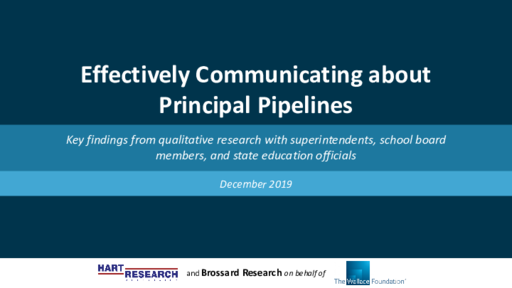Breadcrumb
- Wallace
- Reports
- Effectively Communicating About ...
Effectively Communicating About Principal Pipelines
Key Findings From Qualitative Research With Superintendents, School Board Members, and State Education Officials

Summary
How we did this
This slide deck summarizes key findings of interviews with 36 education decision-makers about principal pipelines. The group was evenly divided among state education officials as well as district superintendents and school board members in medium to large school districts.
Over the last two decades, the role of the principal in ensuring high-quality teaching and learning in public schools has moved from a marginal issue to one high on the education improvement agenda.
But how does the field go about developing a large corps of effective principals?
A groundbreaking study from the RAND Corp., published in spring 2019, found that a comprehensive, systemic approach to training, hiring, and supporting school leaders—known as developing “principal pipelines”—proved to be feasible, affordable, and effective for six large Wallace-supported school districts. These pipelines led to statistically significant benefits in both student achievement and principal retention.
In the wake of the RAND findings, Wallace commissioned market research to help the foundation and others communicate effectively about pipelines. The idea was to understand how state and local education decision-makers view principals, what benefits of pipelines were most important to them, and what barriers they viewed to putting pipelines in place.
The research found broad acceptance of the idea that effective principals are key to good schools.
At the same time, most of those interviewed reported that identifying and attracting high-quality, effective principals is a major challenge. Reasons include the difficulty of finding candidates who are not just campus administrators but adept at supporting effective instruction.
The response to the description of the principal pipeline as a way to develop a robust corps of effective principals was “resoundingly positive." Interviewees indicated that the fact that the benefits for student achievement were statistically significant was the most compelling impact of pipelines.
But a key challenge in advancing pipelines was that many leaders believe they already have in place a comprehensive, systemic approach to preparing and supporting principals. This suggests a need to build an understanding of the full range of components in a comprehensive pipeline.

If you don’t have good leadership, you’re not going to have the outcomes that you want for kids. So, you’ve got to invest in that.
— Education official interviewed as part of the research
Key Takeaways
Principals are viewed as absolutely critical to the success of a school, its teachers, and its students.
There is a general recognition of the need to increase capacity within districts in order to be better prepared to fill principal positions with strong candidates.
The challenges of identifying and attracting high-quality, effective principals vary from district to district, but most say it is a major challenge.
One key challenge is that many districts believe they already have a comprehensive, systemic approach to supporting principals when, in fact, they do not.

